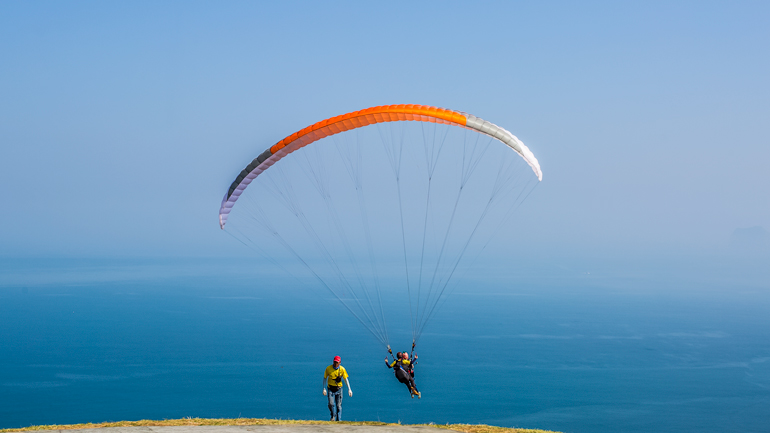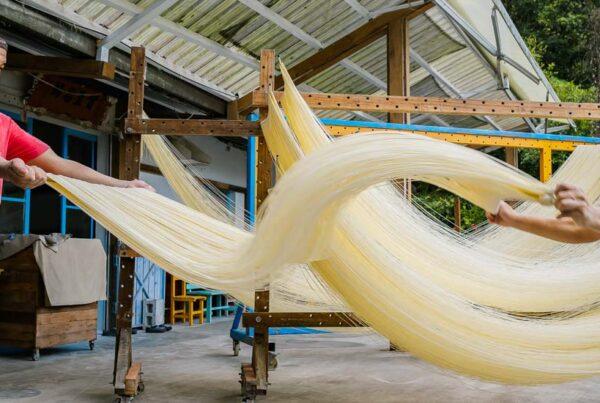To the Twin Candlstick Islets and Back
Text: Francesca Chang, Photos: Maggie Song
A trending watersport, standup paddleboarding is an outdoor activity that combines elements of surfing and kayaking. With tours organized by local outfits, you can now explore such beautiful areas as Taiwan’s amazing North Coast while paddling on the open sea, safe and relaxed, in “new style.”
Taiwan’s clear, blue coastal waters are a beautiful sight, enjoyed by both local and foreign tourists. The numerous bays and capes of the North Coast present a coastline of enchanting rock formations, rugged cliffs, rolling green hills, and pristine beaches. This is an area with many watersport options, and on a recent trip to the North Coast town of Jinshan I explored the wonders of coast and sea from the open water while enjoying a new and increasingly popular outdoor sport, standup paddleboarding.Also read:
Fine Scenery and Comfy Cafés along the NORTH COAST


Like surfing, standup paddleboarding, or “SUP,” has its origins in Hawaii. There are similarities between the two, but unlike surfers, who stand on a significantly smaller board riding waves and trying to keep their balance, standup paddleboarders have a much larger, wider board that is easier to stand on, and use a paddle to propel themselves. Relaxed paddleboarding can be done on rivers, on lakes, and even on the open sea, as long as the water is calm enough. More adventurous SUPers can of course also tackle waves and do SUP surfing.
Paddleboarding is a fairly new watersport in Taiwan, and a number of outfits offer tours for outdoor enthusiasts who want to try something new. One of these is Breeze SUP, a group that started offering standup paddleboarding trips in Taiwan five years ago and actively endeavors to promote the sport. Its instructors all hold licenses from the Academy of Surfing Instructors (ASI), the international governing body for surfing, standup paddleboarding, and bodyboarding. In addition, the team of trainers can provide instruction in Chinese, English, Russian, and Spanish. Clearly, foreign guests are welcome! Outings are usually three hours long, and groups of up to 10 can be accommodated. Currently, Breeze SUP organizes trips by the town of Jinshan on the North Coast, at Fulong and Shen’ao (Elephant Trunk Rock) on the Northeast Coast, and on Dahu, a lake in Yilan County.
Jinshan is a district of New Taipei City. Among its tourist attractions are the Juming Museum, the Teresa Teng Memorial Park, and the Dharma Drum Mountain World Center for Buddhist Education. All three are located in the foothills between the coast and the mountains of Yangmingshan National Park. Closer to the coast are Jinbaoli Old Street, attracting food lovers with duck meat restaurants and sellers of other culinary specialties, and a number of hot-spring hotels, some of which offer hot-spring bathing with sea views. From Jinshan’s Shitoushan Park you can enjoy great views of the ocean, and will spot two rocky outcrops sticking straight up out of the water just off the coast – the Twin Candlestick Islets. This was the destination on my recent standup paddleboard outing with Breeze SUP on the North Coast.

Together with a couple of friends, I arrived at the designated meet-up location in Jinshan on a weekday morning at 8am sharp. The Breeze SUP instructors wanted an early start to avoid any strong currents or waves. We parked our car close to tiny Shuiwei Fishing Harbor, on the east side of Shitoushan Park, and were greeted by our instructors. We suited up, then descended onto a small beach, the instructors thankfully carrying the large paddleboards for us.
The team leader, Ricky Wu, walked us through a short demonstration on land, instructing us on how to paddle out into the water, how to stand up on the board, and how to properly paddle. I then laid down on the board with the paddle blade placed under my chest and the paddle staff pointing forward and upward like a “rhino horn.”

Ricky gave me a push, and once out on the water I began to paddle with my arms. Next, after leaving the shallow waters, I got up on my knees, grabbed the paddle with two hands, held it out in front perpendicular to my body, tucked my toes, and stood up. Since I had tried paddleboarding once before, and frequently go surfing, I was able to find my balance easily. For beginners, however, it is recommended that you stay on the knees for a while and practice your paddling first. This paddling method is also more relaxed. The Breeze SUP instructors will patiently guide you through the initial steps, until you feel confident enough to fully stand up.
Although it may seem that SUP is an arm workout, it actually is a complete ab workout. Core stability and strength is required to work the paddle, which is moved back and forth to your left and right sides. It took a while for me to figure out the correct stroke motion, but the instructors were always close by, providing helpful tips and guidance that made the learning experience enjoyable.

From the fishing harbor, we paddled out onto the open sea all the way to the Twin Candlestick Islets. This unique rock formation, with a height of 60 meters, was once a part of Jinshan Cape, on which Shitoushan Park is located. Though called “islets,” the two candlestick pillars in fact stand atop a single exposed foundation. Due to coastal erosion and the movement of tectonic plates, the towering formation became separated from the mainland, and is now located 450 meters offshore. Originally, the two pillars were connected at the top, forming a giant stone arch. Today, with the top connection gone, the rocks resemble two candlesticks when seen from a distance. The water surrounding the islets, 19 meters deep and teeming with colorful marine life, is a popular site for scuba diving.

We weren’t in any hurry to get to the Twin Candlestick Islets, and the instructors’ laid-back attitude made the journey a fun one. We even played games along the way. We captured memorable photos of each other jumping off our boards, and raced each other climbing back on. The instructors also showed me how to do short paddle strokes (for speed racing), how to steer, and how to turn my board around with my paddle.

After posing for some photos in front of the unique Twin Candlestick Islets, we decided to stop for a rest at Mystery Beach on Jinshan Cape. As we approached the white-sand beach, the clear, shallow waters began to sparkle. Through the transparent liquid, we spotted bright-blue fluorescent fish in the coral reefs below, a small glimpse into the island’s marine wonders. After hauling our boards up on the beach I sat down for my well-earned break from our demanding workout – but our fun-loving instructors dove right back into the waves for a swim and a splash. As I laid down on the soft sand and looked up at the blue skies, the calming sound of the ocean waves reminded me of how close I was to Taiwan’s natural environment in that moment, and how people who spend time in Taiwan can easily miss the island’s true beauty.

The time soon came to get back in the water. I paddled out first with my “rhino horn” once again pointing the way. I quickly got up into a comfortable standing position, and began looking slowly about, mesmerized by the beautiful rock formations close by, rolling green hills further away, and crystal-clear water below. We paddled back to our original launch point, and as we approached the shore we were even able to try a bit of surfing on the tiny waves. When on the beach, I looked back out at the ocean, tired from the workout. The three-hour expedition under the sun had been enough for me, but not for two of the instructors. After they helped us return our boards, they grabbed two racing paddleboards (longer and narrower, designed for speed and glide efficiency) and headed out for their own recreation, paddling furiously to the horizon.
It will be no surprise to you that I highly recommend paddleboarding on Taiwan’s beautiful North Coast. You get as close to nature as is possible, experiencing the island’s natural beauty from the sea while having great fun and working out!

Apart from outings at Jinshan, Breeze SUP also offers trips for more advanced paddleboarders to the iconic Elephant Trunk Rock, located near Shen’ao Fishing Harbor on the Northeast Coast. The stronger currents at this location make the paddling more challenging and exciting. Breeze SUP also organizes outings to Dahu (Big Lake), in Yilan County’s Yuanshan Township, that are open to all. The calm lake waters allow for a variety of fun group activities. Groups of up to 10 people, for example, are challenged to stand on the same board together, jump from board to board, and paddle in tight rows. Paddleboard fishing is another activity offered at the lake; a longer and wider board is provided for this activity to provide better stability when casting.
KLOOK offers:
Taipei Popular Sightseeing Private Car Charter: Tamsui, Northern Coast, and Ju Ming Museum (Chinese/English/Korean/Japanese)
Taiwan’s Northern Coast
Taipei North Coast Day Tour with Tofu DIY Experience
Also read:
The Rugged Northeast Coast
FLYBOARDING on the North Coast
PARAGLIDING at Wanli on the North Coast
Where to Stay (Tamsui)
Where to Stay (Keelung)
How to book: Reservations are required, and can be made online at www.isup.com.tw. The three-hour paddleboard experience at Jinshan costs NT$1,800 for adults on weekdays, and NT$2,200 on weekends (half-price for children up to 12).
What to wear: Wear a bathing suit, and protect yourself against the sun. Waterproof pants and rashguards can be bought at most sporting shops around Taiwan. Sunglasses are highly recommended, due to the sometimes strong direct and reflected sunlight.
Getting there: To get to Jinshan by public transport, you can take a bus following the coastal highway, including No. 862 (Tamsui-Keelung line or Crown Northern Shuttle Bus line from Tamsui to Guihou Fishing Harbor) and No. 863 (Tamsui-Jinshan). There is also a bus service connecting Taipei Main Station with Jinshan via Yangmingshan (Kuo-Kuang No. 1815). The staff at Breeze SUP can pick you up if you call in advance.
Tel: 0932-332-942
Website: www.isup.com.tw
FLYBOARDING on the North Coast
taiwaneverything.cc/2018/07/24/flyboarding-on-the-north-coast/
PARAGLIDING at Wanli on the North Coast
About the author


















